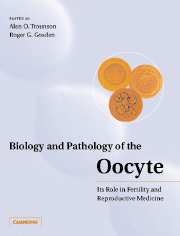Book contents
- Frontmatter
- Contents
- List of contributors
- Preface
- Part I Historical perspective
- Part II Life cycle
- 2 Ontogeny of the mammalian ovary
- 3 The early stages of follicular growth
- 4 Modelling the dynamics of ovarian follicle utilization throughout life
- 5 Comparative aspects of oogenesis
- Part III Developmental biology
- Part IV Pathology
- Part V Technology and clinical medicine
- Index
2 - Ontogeny of the mammalian ovary
from Part II - Life cycle
Published online by Cambridge University Press: 05 August 2016
- Frontmatter
- Contents
- List of contributors
- Preface
- Part I Historical perspective
- Part II Life cycle
- 2 Ontogeny of the mammalian ovary
- 3 The early stages of follicular growth
- 4 Modelling the dynamics of ovarian follicle utilization throughout life
- 5 Comparative aspects of oogenesis
- Part III Developmental biology
- Part IV Pathology
- Part V Technology and clinical medicine
- Index
Summary
Introduction
This chapter deals with the ontogeny of the mammalian ovary from the formation of the sexually undifferentiated gonad to follicle formation and growth in the early sex-differentiated ovary.
The ontogeny of the mammalian ovary involves the following main processes: (1) differentiation of the ovarian pathway from the sexually undifferentiated gonadal anlage; (2) onset and progression of meiosis in the female germline; (3) formation of meiotic diplotene oocytes; and (4) enclosure of the diplotene oocytes in follicles. These processes depend on a finely tuned interaction between germ cells and somatic cells.
Formation of the sexually undifferentiated gonad
During fetal life, the gonads develop on the ventral cranial part of the mesonephros, the second fetal kidney anlage (Figure 2.1). Although the gonadal sex is determined by the genetic sex, the gonads are initially sexually undifferentiated with no morphological difference between the future ovary and testis. The sexually undifferentiated gonad is bipotential with capacity to differentiate into a testis as well as an ovary. It becomes macroscopically recognizable as a swelling, termed the genital or gonadal ridge, on the ventral side of the mesonephros around embryonic day 34 (E34) in humans (van Wagenen and Simpson, 1965) and E10 in mice (Byskov, 1982). The sexually undifferentiated stage lasts until approximately E42 in humans (van Wagenen and Simpson, 1965) and E12.5 in mice (Upadhyay et al., 1981), when gonadal sexual differentiation is initiated.
The sexually undifferentiated gonad consists of a homogenous mixed mass of somatic cells and diploid germ cells. Like other organs facing the coelomic cavity, the gonad is covered by coelomic epithelium. The somatic cells originate from the various cell populations within the area of the presumptive gonad, whereas the germ cells arise extra - embryonically and reach the area of the presumptive gonad by migration. It is the arrival of the diploid germ cells to this area which initiates the development of the gonad. The migrating germ cells are referred to as primordial germ cells (PGCs) (Izpisua- Belmonte et al, 1990).
Primordial germ cells
The origin and migratory route of the PGCs have been difficult to establish due to a limited number of tracing markers. The enzyme alkaline phosphatase is highly expressed in PGCs and has been used as a PGC marker.
- Type
- Chapter
- Information
- Biology and Pathology of the OocyteIts Role in Fertility and Reproductive Medicine, pp. 13 - 28Publisher: Cambridge University PressPrint publication year: 2003
- 1
- Cited by



